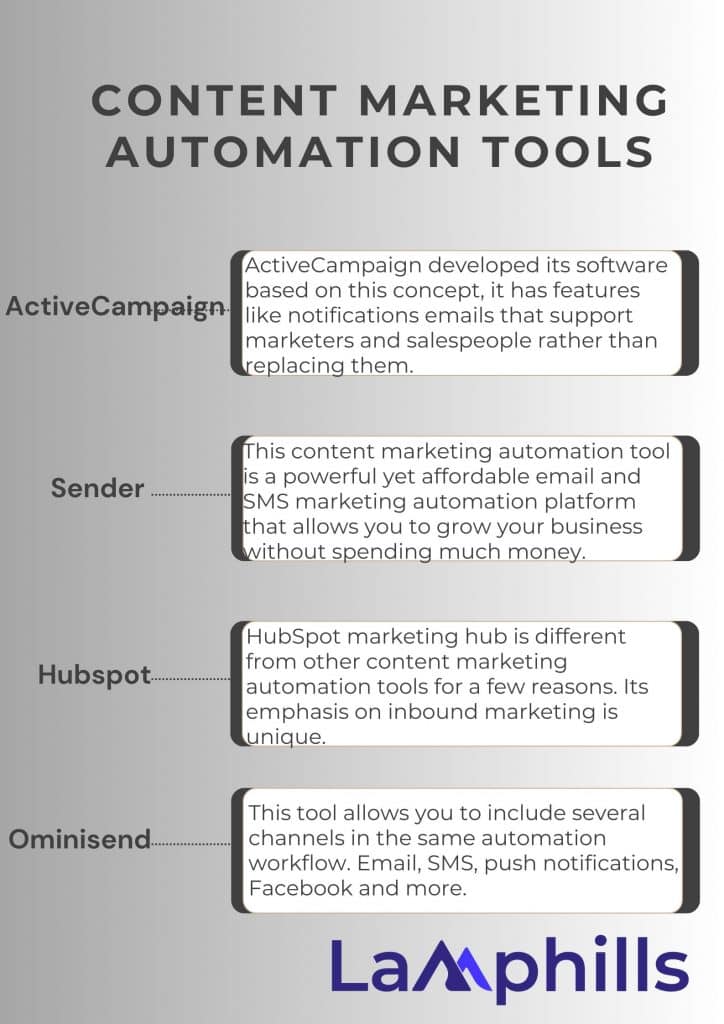In today’s digital world, standing out from competition is very challenging. Content marketing came forth as an effective inbound marketing technique that can not only help you differentiate your brand but also help establish your authority and build a lasting relationship with your audience. Content marketing automation makes it easy to streamline content creation, it allows you to make more smart decisions and encourage qualified leads.
Let’s explore content marketing automation tools. Continue reading to learn more.
You might also like to read Evergreen Content Strategies: How to Keep Your Business Blog Relevant and Engaging
Key points
- Content marketing automation streamlines repetitive tasks, enhancing the overall strategy and effectiveness of content marketing.
- Content marketing automation establishes clear goals for automation, such as increasing post reach, publishing consistently, and engaging with the audience effectively.
- When selecting a content marketing automation tool, you need to Identify your needs and choose a user-friendly marketing automation tool that integrates well with other software.
- While using the automation tool, start automating with one simple task, like reposting blog content on social media, and gradually add more tasks as you gain familiarity.
- Create clear automation workflows, set benchmarks, and continuously monitor and adjust performance for optimal results.
Content Marketing Automation
Content marketing automation is a strategy used to help identify repetitive content marketing tasks and also to automate those tasks using tools and apps. Its purpose is to assist marketers and brands to improve their overall strategy and effectiveness of content marketing. Every stage in the content marketing process starts from strategy, planning, creation, then distribution, and management.
All can benefit from the application of content marketing automation. There are many content marketing automation tools like the ones that publish content automatically for diverse social media platforms, and there are some other tools that are programmed to examine your blog data analytics.
Read Also: What Is a UGC Content Creator? A Guide to Becoming One in 2024
How to Use Content Marketing Automation
I used to spend a lot of time on tasks like scheduling posts, tracking progress, and managing my content calendar. This affected my writing because I had only little time to write which was very frustrating. However, when I learned about content marketing automation, I discovered how helpful automation is if you set it correctly. It was not an instant fix, it required setup and management.
My experiences and process with content marketing automation made me create this guide to help you use content marketing automation the right way. The following include tips and guides on how to use content marketing automation to make your work easier.
#1. Determine Your Goals
When I started using automation, I was not sure of where to begin. My mentor, Chloe told me a story about how she once automated her content without a clear goal and ended up with a post that didn’t engage her audience. She told me to start by setting clear goals and I saw the importance of having specific goals in mind.
Since it’s about content marketing, you will have goals like enhancing your post reach, publishing and sharing more content consistently, plus engaging with your audience through your content.
Tips: To achieve these while using automation, you will have to schedule your post at the best times to increase your post reach especially when your audience is active. To maintain a regular schedule of publishing and sharing content, you should create a content calendar and use automation to maintain a regular posting schedule.
Also, automate the sharing of your older evergreen content and set up automated responses for common questions or comments to help you stay responsive and engaged with the -audience without glancing at your screen 24/7.
#2. Select Your Marketing Automation Tool
With your goal in mind, you can search for the right automation software to help you achieve your now and future goals. The first time I decided to use a marketing automation tool, I was overwhelmed by the options available but a bit excited too. I needed a tool that would do things like publishing content consistently and engaging well with my audience.
I tried out a few and discovered that all the tools are not equal, some are complex while others didn’t have the features I needed. Afterwards, a friend recommended a tool that was easy and had all the features I required.
Tips: Before you select the right automation tool, you need to identify your needs, you may make a list of the features you need based on your goals. Test out some tools to see the one that works for you. Then choose a tool that is user-friendly and integrates well with other software you use.
Ensure you look out for reviews from other users and ask for their recommendations because their experiences can offer you some relevant insights.
#3. Decide on Your Task
When you start using marketing automation tools, start with one content marketing task like using automation to repost blog content on social media. I recall the mistake I made in the past when I was trying to automate so many tasks at once. This led to a few setbacks for me. My mentor, Chloe shared a tip that changed my approach.
She encouraged me to start with one simple task. After that, I started automating one single task at a time and it helped me maintain a consistent presence, especially on social media without spending hours to post manually.
Tips: To decide on your first task, you need to choose a straightforward task that will save you time and effort. Assess the impact of automation on your workflow and results to see whether there is an increase in your content reach and engagement. When you must have become familiar with the automation tool, pay attention to how the automation is performing and make necessary adjustments.
#4. Segment Your Audience
After deciding on your task, you should divide your audience according to your goal. For example, segmenting your audience by Facebook users that are interested in your blog post topic. I realized that sending the same message to an entire audience was not effective some time ago while using content marketing automation. I learned from a senior colleague that campaigns without segmenting your audience properly don’t yield good engagement rates. She advised me to always segment my audience to make sure that the right people receive the right content. I took her advice and segmented my audience based on their interest and behaviours.
Read: How I Use Seamless Instagram Carousels to Boost Engagement: 9 Tips for Getting Started
For instance, I used an automation tool to repost content on Facebook and identify Facebook users who showed interest in similar topics, this approach enabled me to shape my customized messages to increase audience engagement.
Tips: To segment your audience you need to look at their data to identify the key segments based on interest, behaviors, demographics, or any other relevant factor. After that, use your automation tools to create and manage your segments easily.
#5. Create an Automation Workflow
After you have segmented your audience, the next is to create the automation workflow rules. This works based on automation software where some tools will allow you to drag and drop parts of the workflow which is faster and more effective. The idea of creating workflows seemed discouraging when I first used automation.
I tried to find easy and best ways to set up my tasks. I used a drag-and-drop feature in my automation tool to make the process so much simpler and more efficient. Automation workflow operates on an “if/then” premise, meaning if A happens then B should be taken. This gives you clarity when you map out your process.
Tips: To create an effective automation workflow, you should use drag-and-drop tools. This tool it easy for you to set up your workflow. Ensure that you clearly define your if/then rules, and state what triggers an action and what follows an action. After that, test your workflow before implementing it. Then monitor the performance so that you can make adjustments where necessary.
#6. Review Metrics
If you are satisfied with your setup, take your automation workflow live. I recall some time ago, I took my automation workflow live and this brought both excitement and nervousness. I was so nervous because I was anticipating seeing the results of my hard work. In your case, if you are fortunate, you may notice some improvements like more posts, more views, increased engagement, and a significant rise in interactions.
Tips: Before you review your metrics, set a clear benchmark to help you measure the effectiveness of your automation. It can be several likes, views, comments, or shares. Use analytics tools to track performance metrics to see what’s working for you and areas where improvement is needed. You will need continuous adjustments every time it is needed to maintain the benefits of automation. Finally, Celebrate every increase in engagement no matter how small it is.
Below is a checklist that will help you create a comprehensive and valuable resource that will help your readers effectively set up and use their content marketing automation.
Lamphills Content Automation Checklist
Read Also: Using AI in Influencer Marketing: Best Strategies for Successful Campaigns
Content Marketing Automation Tools
You need to start with the right automation tool to take your content to the next level. I recall the first time I ventured into content automation. I was overwhelmed by the number of tools available and I was not sure of the one to choose. After trying a few of them, I found a perfect fit that transformed my marketing strategy and made my efforts more effective.
Now, I have carefully selected a few content marketing automation tools to help you simplify your process, enhance your top choice, and achieve your marketing goals with ease.

#1. ActiveCampaign
This automation tool works in real human processes. In reality, automation platforms do not handle everything, some aspects of marketing require a human touch. ActiveCampaign developed its software based on this concept, it has features like notifications emails that support marketers and salespeople rather than replacing them.
Pricing: Depending on the features and number of contacts, ActiveCampaign monthly cost ranges from $29 to $149.
#2. Sender
This content marketing automation tool is a powerful yet affordable email and SMS marketing automation platform that allows you to grow your business without spending much money. Sender is created to assist e-commerce store owners, small business owners, bloggers, and B2B startups automate their email and SMS marketing campaigns. The sender automation tool offers segmented lists and a form/pop-up builder as well as other features. This is an outstanding tool for businesses and it aims to expand their subscriber lists, boost audience engagement, and increase their revenue quickly.
Pricing: Its monthly cost starts at $15 and differs based on the number of subscribers; emails sent and additional services. It also provides a free plan that lasts for up to 2500 subscribers and 15000 emails every month
#3. Hubspot
HubSpot marketing hub is different from other content marketing automation tools for a few reasons. Its emphasis on inbound marketing is unique. Additionally, it comes with the additional benefit of CRM, sales, and service which means your team can work better together even across departments.
Pricing: HubSpot’s pricing varies from $800 to over $ 3600 per month based on the required features and scale of use.
#4. Ominisend
This tool is more comprehensive than others. It has an omnichannel function that makes this marketing automation platform stand out from others on the list. It allows you to include several channels in the same automation workflow. Email, sms, push notifications, Facebook, and more. This implies that you can provide your customers with an immersive omnichannel experience that allows you to deliver messages automatically through the channel they’ve chosen. The Omnisend platform is worth considering because it offers advanced targeting, split automation, and an easy drag-and-drop builder.
Pricing: Omnisend provides a free package for important email marketing. The automation packages start at $16 per month and can be adjusted for enterprise-level pricing based on the automation features needed and the number of contacts.
What Is an Example of Content Automation?
Mailchimp Automation Workflows are a popular example of content automation. This tool enables organizations to develop customized email marketing campaigns that are delivered to subscribers depending on predetermined triggers. For example, when a new subscriber signs up, they may receive a series of welcome emails automatically.
What Is Content Automation in SEO?
Content automation is the use of software to automatically generate or populate content. Examples include marketing elements such as blog entries, product descriptions, social media posts, and even site pages from a standard web design checklist.
How Do You Explain Marketing Automation?
Marketing automation is software that performs routine marketing tasks without the need for human intervention. Personalized advertising, lead prioritizing, behavioural targeting, and email marketing are examples of common marketing automation operations.
Can Content Writing Be Automated?
The application of artificial intelligence and automation in content creation and distribution may alter how businesses create and exchange content. Artificial intelligence tools can help a content writing agency. It can make material more effective and even provide personalized content targeted to each client.
References
Related Articles
- Guide to Becoming a Successful Digital Content Creator [+ Tips To Get Started]
- A Comprehensive Guide to AI Marketing Automation and Best Tools in 2024
- Utilizing Marketing Automation for Effective Lead Generation
- Outsourced Marketing: A Detailed Guide to Using Outsourced Marketing Solutions for Small Businesses
- 13+ Must-Have AI Automation Tools in 2024: A Complete Guide





